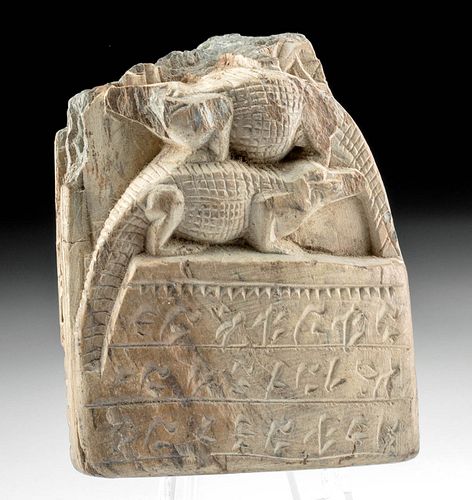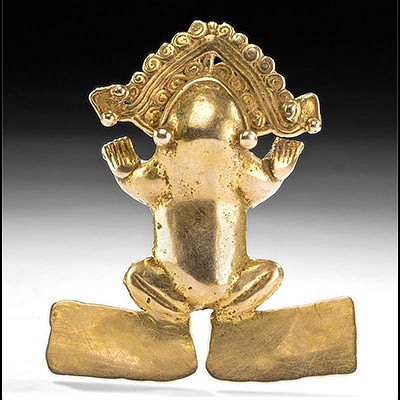Egyptian Late Dynastic Carved Stone Cippus - Ex Ede
Lot 4a
About Seller
Artemis Fine Arts
686 S Taylor Ave, Ste 106
Louisville, CO 80027
United States
Selling antiquities, ancient and ethnographic art online since 1993, Artemis Gallery specializes in Classical Antiquities (Egyptian, Greek, Roman, Near Eastern), Asian, Pre-Columbian, African / Tribal / Oceanographic art. Our extensive inventory includes pottery, stone, metal, wood, glass and textil...Read more
Categories
Estimate:
$1,500 - $2,000
Absentee vs Live bid
Two ways to bid:
- Leave a max absentee bid and the platform will bid on your behalf up to your maximum bid during the live auction.
- Bid live during the auction and your bids will be submitted real-time to the auctioneer.
Bid Increments
| Price | Bid Increment |
|---|---|
| $0 | $25 |
| $300 | $50 |
| $1,000 | $100 |
| $2,000 | $250 |
| $5,000 | $500 |
| $10,000 | $1,000 |
| $20,000 | $2,500 |
| $50,000 | $5,000 |
| $100,000 | $10,000 |
| $200,000 | $20,000 |
About Auction
By Artemis Fine Arts
Aug 13, 2020
Set Reminder
2020-08-13 10:00:00
2020-08-13 10:00:00
America/New_York
Bidsquare
Bidsquare : Fine Antiquities, Ethnographic & Fine Art
https://www.bidsquare.com/auctions/artemis-gallery/fine-antiquities-ethnographic-fine-art-5415
Features classical antiquities, ancient and ethnographic art from cultures encompassing the globe. Egyptian, Greek, Roman, Etruscan, Near Eastern, Asian, Pre-Columbian, Native American, African / Tribal, Oceanic, Spanish Colonial, Russian, Fine Art, so much more! Artemis Fine Arts info@artemisfinearts.com
Features classical antiquities, ancient and ethnographic art from cultures encompassing the globe. Egyptian, Greek, Roman, Etruscan, Near Eastern, Asian, Pre-Columbian, Native American, African / Tribal, Oceanic, Spanish Colonial, Russian, Fine Art, so much more! Artemis Fine Arts info@artemisfinearts.com
- Lot Description
Ancient Egypt, Late Dynastic period, ca. 712 to 332 BCE. A carved stone panel cippus, a votive plaque which once would have depicted the god Horus standing atop the two crocodiles, one of which is nicely preserved here. Below the crocodiles are three panels of hieroglyphs; the back of the plaque also has hieroglyphs incised into it. This example is made from a pretty piece of hard, layered stone, a type of brown slate. The crocodile present is well-carved, lifelike, with a nice attention to detail, indicating that the piece was made by a talented artist. Cippus amulets (cippi) became popular during the New Kingdom and continued to be popular until the Roman period. Egyptians believed that possessing one of these plaques could protect them from attacks by wild animals - a real problem in the Egyptian world. Size: 2.25" W x 2.75" H (5.7 cm x 7 cm)
The iconography of "Horus on the Crocodiles" stems from the story of Horus, hidden in marshes from his enemy Seth by his mother Isis so that he could heal from scorpion stings and snakebites. The protective spells on front and back of a cippis could be activated by pouring water over it and into a bowl, to be drunk by the person seeking protection. Smaller portable amulets like this one could be submerged in water, and then the water ingested ritually. Made to be treasured by hunters or anyone who had to venture beyond the safe space of the Nile delta into the wild peripheries of Egypt.
Provenance: private East Coast, USA collection; ex Charles Ede; ex Gustave Mustaki, Alexandria, Egypt, exported from Egypt to the UK under license 1949
All items legal to buy/sell under U.S. Statute covering cultural patrimony Code 2600, CHAPTER 14, and are guaranteed to be as described or your money back.
A Certificate of Authenticity will accompany all winning bids.
We ship worldwide and handle all shipping in-house for your convenience.
#157315Piece is a fragment as shown. Nicely preserved on the side with the crocodiles aside from the loss of Horus; the back of the piece has some preserved hieroglyphs.Condition
- Shipping Info
-
All shipping is handled in-house for your convenience. Your invoice from Artemis Gallery will include shipping calculation instructions. If in doubt, please inquire BEFORE bidding for estimated shipping costs for individual items.
-
- Buyer's Premium



 EUR
EUR CAD
CAD AUD
AUD GBP
GBP MXN
MXN HKD
HKD CNY
CNY MYR
MYR SEK
SEK SGD
SGD CHF
CHF THB
THB














